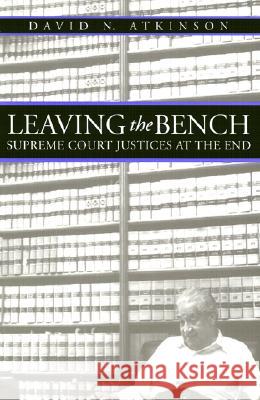Leaving the Bench: Supreme Court Justices at the End » książka
topmenu
Leaving the Bench: Supreme Court Justices at the End
ISBN-13: 9780700609468 / Angielski / Twarda / 1999 / 262 str.
Leaving the Bench: Supreme Court Justices at the End
ISBN-13: 9780700609468 / Angielski / Twarda / 1999 / 262 str.
cena 403,20
(netto: 384,00 VAT: 5%)
Najniższa cena z 30 dni: 314,20
(netto: 384,00 VAT: 5%)
Najniższa cena z 30 dni: 314,20
Termin realizacji zamówienia:
ok. 30 dni roboczych
Dostawa w 2026 r.
ok. 30 dni roboczych
Dostawa w 2026 r.
Darmowa dostawa!
Suffering from a bad heart, emphysema, glaucoma, and deafness, Thurgood Marshall finally retired from the Supreme Court at the age of 82 in spite of having always claimed "I was appointed to a life term, and I intend to serve it." Many observers felt he should have left much earlier.
Life appointments make Supreme Court justices among the most powerful officials in government and allow even dysfunctional judges to stay on long after they should have departed. For that reason, when a justice leaves the bench is often as controversial as when he's appointed. This first comprehensive historical treatment of their deaths, resignations, and retirements explains when and why justices do step down. It considers the diverse circumstances under which they leave office and clarifies why they often are reluctant to, showing how factors like pensions, party loyalty, or personal pride come into play. It also relates physical ailments to mental faculties, offering examples of how a justice's disability sometimes affects Court decisions. David Atkinson examines each of the nearly 100 men who have left the bench and provides anecdotal glimpses into the lives of famous and obscure justices alike. He reveals how men like Salmon Chase and William O. Douglas determinedly continued to serve after suffering strokes, how Joseph McKenna persevered despite knowing he was professionally unqualified, and how, long before Thurgood Marshall, the ailing octogenarian Gabriel Duvall finally retired after struggling to protect another ideological position on the Court. Ultimately, Atkinson shows just how human these people are and enhances our understanding of how the Court conducts its business. He also suggests specific ways to improve the present situation, weighing the pros and cons of mandatory retirement and calling for reform in the delegation of duties to law clerks--who in recent years have dominated the actual writing of many justices' decisions. As the current Court ages, how long might we expect justices to remain on the bench? Because our next president will likely make several appointments, now is the time to consider what shape the Supreme Court will take in the next century. Offering a wealth of information never before collected, Leaving the Bench provides substantial grist for that debate and will serve as an unimpeachable reference on the Court.










